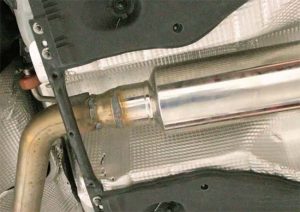Every car is a masterpiece of engineering, with numerous parts and components working together to ensure smooth functioning. Among these myriad parts is the resonator, an integral yet often overlooked component. The primary aim of this article is to shed light on the physical appearance of the resonator and delve into its significance in a vehicle’s exhaust system.
Upon examining the underbelly of a vehicle, one might come across various tubes and components. Among these, the resonator stands out with its unique design. Typically crafted from durable materials like stainless steel or aluminum, the resonator boasts a predominantly tubular shape. While there might be slight variations in its design based on the vehicle’s make and model, its fundamental cylindrical structure remains consistent. Its surface might be smooth or corrugated, depending on its design intricacies. Recognizing this component is essential for those keen on understanding their vehicle better.
Functions of the Resonator in a Vehicle
The resonator is not just an ornamental piece; it plays a significant role in the car’s exhaust system. Its duties include:
-
Noise Reduction: One of the resonator’s primary functions is to assist in dampening the noise produced by the engine. It achieves this by creating sound waves that counteract unwanted noise, ensuring passengers enjoy a quieter ride.
-
Optimizing Engine Performance: Apart from noise control, the resonator also plays a role in fine-tuning the exhaust flow, which in turn can have a positive impact on the engine’s performance. By ensuring that the exhaust gases flow without interruption, the resonator aids in maintaining optimal engine functionality.
-
Elimination of Specific Frequencies: While mufflers address a broad range of noises, the resonator is designed to target and eliminate certain unwanted sound frequencies. This ensures that the sound emanating from the exhaust system is not only quieter but also more refined and pleasant.
Resonators vs. Mufflers: The Key Differences
 Though both resonators and mufflers are components of a vehicle’s exhaust system, they serve distinct functions. A muffler’s primary purpose is to reduce the overall sound level of the exhaust system, employing baffles and chambers to reflect and absorb sound waves. On the other hand, a resonator specifically targets and eradicates certain problematic frequencies, ensuring a refined sound quality. While mufflers are often larger and more bulbous, resonators maintain a more streamlined, tubular appearance. Understanding these differences is crucial when diagnosing issues or when considering modifications to the vehicle’s exhaust system.
Though both resonators and mufflers are components of a vehicle’s exhaust system, they serve distinct functions. A muffler’s primary purpose is to reduce the overall sound level of the exhaust system, employing baffles and chambers to reflect and absorb sound waves. On the other hand, a resonator specifically targets and eradicates certain problematic frequencies, ensuring a refined sound quality. While mufflers are often larger and more bulbous, resonators maintain a more streamlined, tubular appearance. Understanding these differences is crucial when diagnosing issues or when considering modifications to the vehicle’s exhaust system.
The Importance of Resonator Maintenance
Like any other vehicle component, the resonator requires regular maintenance to ensure it performs optimally. Over time, resonators can accumulate carbon deposits, leading to blockages that might hamper their efficiency. If a vehicle begins to sound unusually loud or emits unfamiliar noises, it might indicate resonator issues. Regular inspections by a trusted mechanic can help identify and rectify such problems early on, ensuring the longevity of the component and maintaining the desired sound quality. Remember, a well-maintained exhaust system can significantly impact a vehicle’s overall performance and efficiency.
Conclusion
The resonator, while not as widely discussed as some other car components, plays a crucial role in shaping the auditory experience within and outside a vehicle. By refining and tuning the exhaust sound, it ensures a pleasant driving environment and aids in optimal engine performance. As with all vehicle parts, regular checks and maintenance of the resonator are essential for a smooth driving experience. For those looking to further enhance their vehicle’s performance, it might be worth considering products like the Best Cold Air Intake for Toyota Camry to optimize airflow and improve overall efficiency.


Add Comment